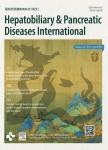Risk factors for postoperative bile leakage:a retrospective single-center analysis of 411 hepatectomies
Risk factors for postoperative bile leakage:a retrospective single-center analysis of 411 hepatectomies作者机构:Department of General and Liver Transplant SurgeryMontpellier University HospitalCollege of Medicine
出 版 物:《Hepatobiliary & Pancreatic Diseases International》 (国际肝胆胰疾病杂志(英文版))
年 卷 期:2016年第15卷第1期
页 面:81-86页
核心收录:
主 题:liver resection bile leakage wedge total vascular exclusion
摘 要:BACKGROUND: The primary focus of the study was to ana- lyze the risk factors for bile leakage after hepatectomy for be- nign or malignant tumors. METHODS: A total of 411 patients who had undergone hepa- tectomy between December 2006 and December 2011 were ret- rospectively analyzed. The severity of bile leakage was graded according to the ISGLS classification. Twenty-eight pre- and postoperative parameters were analyzed. RESULTS: The overall bile leakage incidence was 10.2% (42/411). The severity of the leakage was classified according to the IS- GLS classification. Bile leakage was detected early in case of abdominal drainage (11.4% vs 1.9%, P=0.034). It prolonged the time of hospitalization (16 vs 9 days, P=0.001). In all patients, wedge resection was associated with a higher incidence of bile leakage in contrast to anatomical resections (25.6% vs 4.1%, P〈0.0001) regardless of the underlying liver disease. Furthermore, total vascular exclusion increased risk of bile leakage (P=0.008). CONCLUSIONS: Bile leakage as a major issue after hepatic resection is related to the postoperative morbidity and the hospitalization time. It is associated with non-anatomical re- section and a total vascular exclusion.



